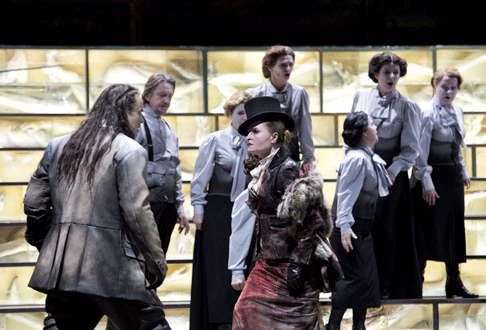She unfastens the ring—here represented as a sequined hand—from
the arm of Siegfried’s corpse, and moves regally upstage. When video
projections of fire onto a shiny back wall cede to blue swirls of water—the
Rhine overflowing after Valhalla has burned to ash—the fading, ghostly image
of a woman with her mouth agape hovers like a virtual nightmare. A crowd of
Gibichungs, dressed in drab civil suits with touches of barbaric fur, turn
toward the back wall and stare at an image of excavated human remains. As their
expressions reveal signs of cognizance, a giant replica of the marble relief
Human Passions by Jef Lambeaux, a depiction of nude bodies writhing
somewhere between heaven and hell, descends and traps the action behind it.
As program notes by the dramaturge Michael Steinberg explain, this image has
provided a kind of Leitmotif for the Ring cycle by stage team
Guy Cassiers and Enrico Bagnoli, which has unfolded in epic fashion over the
past three years in co-production with La Scala. The opening instalment,
Das Rheingold, culminated in a video projection of the full image; in
Die Walk¸re, it mutates into a twisting, multi-media pile of bodies.
Cassiers, the director, has set out to address globalization in an age of
virtual reality and pornographic violence, adopting with Bagnoli a streamlined
yet abstract aesthetic. Laser-like red lines that designate warfare in
Walk¸re reappear as the fragile network (or destiny rope) of the
Norns in Gˆtterd‰mmerung, and rows of white spears that serve as a
canvas for flickering video projections descend to drive home the notion of
human destruction.
While the visual symbolism of Cassiers and Bagnoli is sometimes too
conceptual to connect with its intellectual underpinnings—now a black mass
which spreads like an expressionist painting when Siegfried makes a blood oath
with G¸nther, now a woman who sticks her computerized tongue out at the
audience—the production scores a triumph in the use of light-dark imagery to
mirror the archetypal forces at play, underscoring the music rather than
overwhelming it with images. The restraint bordered on excessive for the
opening scene in the shadowy hall of the Gibichungs, designated by a simple
metal wall and a box of glowing limbs, and it took a moment to realize that a
group of dancers on their knees behind Siegfried represented Grane,
Br¸nnhilde’s horse. Yet choreography by Sidi Larbi Cherkaoui was
surprisingly effective when the bodies draped themselves in black cloth and
transformed into the Tarnhelm, the magic helmet which allows Siegfried to still
the ring from Br¸nnhilde. Costumes by Tim Van Steenbergen, with a modernist
take on Lederhosen for the leading Gibichungs and leather motorcycle
get-up for Siegfried, add to the dystopic vision.
 Ian Storey as Siegfried and Marina Poplavskaya as Gutrune with the State Opera Chorus
Ian Storey as Siegfried and Marina Poplavskaya as Gutrune with the State Opera Chorus
If the production leans too heavily on the audience’s powers of
imagination, Daniel Barenboim, currently music director in both Berlin and
Milan, fills the vacuum with the sharpest insight into dramatic nuance. The
Staatskapelle swelled and subsided with organic ease as the score soared from
subterranean tunnels to celestial plains, mutating like the ring’s magical
forces to accommodate each singer. IrËne Theorin, the cycle’s Br¸nnhilde in
all instalments, threatened to burst the walls of the Schiller Theater when her
seasoned Wagnerian soprano broke out from its round timbre into a screech, but
she inhabited the role of the mortalized goddess with an affecting blend of
dignity, hysteria and vengeance. In the role of Siegfried, Ian Storey, a tenor
of higher vintage than the previous installment’s Lance Ryan last fall,
struggled with a wobble in the opening scenes but warmed up to give an
indomitable performance of the hero before he is stabbed in the back by Hagen.
As the evil Gibichung, Russian bass Mikhail Petrenko was an increasingly
ominous presence, spitting out his words with villainous resolve in the
soliloquy “Hier sitz’ ich zur Wacht.”
It was a surprise to hear Marina Poplavskaja, a dramatic soprano who has
forged an international career in roles such as Desdemona and Violetta, portray
Gutrune—who drugs Siegfried with a magic potion in order to separate him from
Br¸nnhilde—but her voice poured out clearly above Barenboim’s sensitive
conducting and captured the Gibichung’s wicked wiles. She also gave a
pleasant account of the Second Norn. Marina Prudenskaya gave an affecting
performance as the Valykrie, Waltraute, who beseeches Br¸nnhilde to give back
the ring to the Rhinemaidens, and as the Third Norn. The mezzo Margarita
Nekrasova, in the role of the First Norn, did not blend easily but evoked
impending pathos with a more typically Wagnerian voice. Aga Mikolaj, Maria
Gortsevskaya, and Ann Lapkovskaja made for a seductive, youthful trio as the
Rhinemaidens. Even at the Twilight of the Gods, Cassiers’ vision ends the
cycle with the possibility for atonement. Despite the horrors the human race
has wracked upon the environment and itself, it can learn from the past and
start anew.
Rebecca Schmid
Click here for cast and production information.
image=http://www.operatoday.com/Goetterdaemmerung_106.gif
image_description=IrÈne Theorin a Br¸nnhilde and Ian Storey as Siegfried [Photo by Monika Rittershaus courtesy of Staatsoper im Schiller Theater]
product=yes
product_title=Gˆtterd‰mmerung at the Staatsoper Berlin
product_by=By Rebecca Schmid
product_id=Above: IrÈne Theorin a Br¸nnhilde and Ian Storey as Siegfried
Photos by Monika Rittershaus courtesy of Staatsoper im Schiller Theater